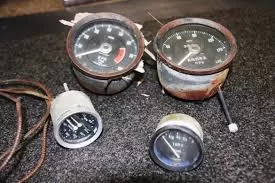When you’re behind the wheel of a classic car or even a newer ride, you rely on your gauges to tell you exactly what’s happening under the hood. That’s why a 1-year warranty tachometer repair can give you the confidence you need when it comes to fixing or restoring your tachometer. Whether you’re driving an old muscle car, a vintage boat, or a daily driver with a failing gauge, finding the right repair shop with a solid warranty can save you headaches and money down the road.
Why a Warranty Matters
You might be wondering why a warranty is important for something like a tachometer. Well, any gauge repair involves small moving parts, delicate mechanisms, and calibration that has to be precise. If something goes wrong after the repair — maybe the needle sticks, the reading is off, or the gauge quits working altogether — a warranty means you’re covered. It shows that the shop stands by its work and isn’t afraid to fix things if needed.

1-year warranty tachometer repair
A 1-year warranty gives you peace of mind. You know you won’t be stuck paying for the same repair twice just because a tiny spring or circuit board failed. For many drivers, this makes the difference between worrying every time you hit the gas and knowing your gauge is reliable.
What Goes Into a Quality Tachometer Repair?
Repairing a tachometer isn’t just about making it look nice again. The process usually starts with a careful inspection. The technician will take the gauge apart, piece by piece, to check for worn gears, faulty wiring, or rust. Some old tachs have mechanical movements that need cleaning, lubrication, and recalibration. Others have electronic components that might require testing with special tools.
A good shop will replace any damaged or worn parts with new or refurbished ones that match the original specs. The dial face might be refinished to look like it did when it left the factory, and the casing can be polished or repainted if needed. Once it’s reassembled, the gauge should be tested for accuracy and performance before being sent back to you.
Real-Life Story: How a Warranty Saved the Day
Take Jake’s story, for example. He drives a restored 1969 Camaro and wanted to keep the original factory tachometer instead of swapping in an aftermarket one. He sent it off to a shop that offered a 1-year warranty tachometer repair. About six months later, the needle started to bounce wildly at high RPMs. Instead of stressing out, he called the shop, shipped the gauge back, and they fixed it at no extra cost. Without that warranty, Jake would have been on the hook for another few hundred dollars — or worse, might have given up and bought a reproduction gauge that didn’t look right.
Signs Your Tachometer Needs Repair
A tachometer doesn’t always just die overnight. Sometimes, the signs start small: the needle sticks, jumps, or reads a little too high or low. You might also hear a faint ticking noise if it’s mechanical. Or, in electronic models, you may see flickering or inconsistent readings. Don’t ignore these signs. It’s easier to fix a minor problem before it turns into a bigger one that could damage the rest of your instrument cluster.
How to Choose a Shop With a 1-Year Warranty
Not every repair shop will offer a warranty, so it’s worth shopping around. Ask questions before you commit. Find out what exactly the warranty covers — does it include parts and labor? Will they pay for shipping if you need to send the gauge back? Read reviews and see if other customers have had to use the warranty. If they have, did the shop honor it without a hassle?
Good shops are proud of their work and stand behind it. They’ll gladly explain the repair process, share before-and-after photos, and answer your questions. Some places even offer test results to show how accurate your tachometer is when it leaves their shop.
The Difference Between Repair and Replacement
You might be tempted to replace your old tach with a modern version. That’s fine for some drivers, but for many classic car owners, originality matters. The original tach fits the dash perfectly, matches the other gauges, and keeps the car’s value higher. Plus, there’s something satisfying about keeping that vintage look alive.
When you choose repair over replacement, you’re preserving a piece of your vehicle’s story. And when you back it with a warranty, you’re protecting that story for at least another year — and probably much longer.
DIY Repairs: Worth the Risk?
If you’re handy, you might think about fixing your tachometer yourself. Simple cosmetic fixes, like cleaning the glass or repainting the needle, can be a fun weekend project. But the inner workings of a tachometer are delicate. One slip can ruin tiny gears or damage electronic components. Worse, you won’t have a warranty if something goes wrong.
If you really want to give it a shot, do your research first. There are videos and guides online that show the basics, but for anything involving recalibration or internal repairs, you’re usually better off trusting a pro.
Keeping Your Repaired Tach in Top Shape
Once you get your tachometer back from repair, treat it well. Keep your vehicle stored in a dry place whenever possible. Moisture is the enemy of old gauges, especially if your car or boat sits unused for long periods. Start the engine regularly, even in the off-season, to keep the electrical system in good shape.
If you notice any changes in the gauge’s behavior, don’t wait. A small problem can become a big repair if ignored. And with your warranty in place, it’s worth checking with the shop while you’re still covered.
Community Tips: Learning From Other Drivers
One of the best ways to find a good repair shop is by talking to other enthusiasts. Join local car clubs, browse online forums, or stop by car shows. Ask people who they’ve used for gauge restoration. Many hobbyists are more than happy to share photos and stories about their repairs — and they’ll tell you if a shop’s warranty really holds up.
Frequently Asked Questions
Q: How long does a tachometer repair usually take?
Most repairs take anywhere from two to six weeks, depending on parts availability and how busy the shop is. If your gauge is rare or needs custom parts, it could take longer.
Q: Does the warranty cover accidental damage?
Usually not. A standard 1-year warranty tachometer repair covers defects in parts and workmanship but doesn’t cover damage caused by accidents, misuse, or improper installation.
Q: Can I still get a warranty if I do part of the work myself?
Most shops won’t offer a warranty if you open the gauge after they fix it. To stay covered, leave the internals alone and let the pros handle any issues.
Q: Is it expensive to get a tachometer repaired with a warranty?
Not necessarily. Many shops include the warranty in their price as a sign of confidence. A simple repair might cost a few hundred dollars, while rare or complex gauges can be more. The peace of mind is usually worth the extra cost compared to replacing the gauge outright.
Conclusion
Getting a 1-year warranty tachometer repair is one of the smartest moves you can make if you care about keeping your car or boat authentic, reliable, and ready for the road (or water). With the right shop, you get more than just a pretty dial — you get the confidence that if something goes wrong, you’re covered. So don’t put up with a bouncing needle or a dead gauge. Find a trusted expert, ask about that warranty, and get ready to enjoy every drive with a tachometer that works just like it should.













